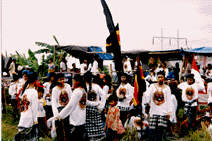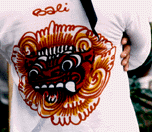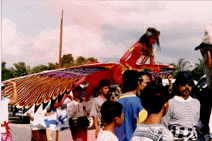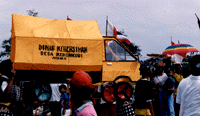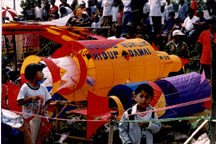Bali Kite Festival
Every two years Indonesia features an international kite festival, which is actually a series of kite festivals held on several of the islands. One of these festivals takes place in Bali. Having seen some of the prior kite articles about the Bali festival, we decided to check it out. After all it was Bob's 50th birthday in, 1996, and like many kiters celebrating personal events at a kite festival seems like a good way to make it memorable.
Ron Gibian suggested we contact the organizer of the festival, Sari Magid, and make arrangements. So with some trepidation (like changes in festival dates after we had airline reservations, getting wait listed on the new dates, Garuda canceling the flight the day we arrived in LA to leave, etc.) we set off into the unknown to see what this famous kite festival was all about. We had some help during this initial period from Terry Shields who had been to 6 previous Indonesian festivals and was able to assuage our fears.
We landed a few days before the festival and got over our jet lag in the village of Ubud. As we woke the first morning and looked out over the field we saw our first Balinese kites flying over the rice field. These were plastic and bamboo and tied off to trees along the rice paddy. They were flying about 1000-1500 feet in the trade winds, flying on monofilament line. The next few days as we drove around, we would pass open rice fields and count the number of kites, 23, 24, 25, etc. that were flying. We marveled at the number of kite bones in the telephone wires.
We arrived in Sanur Bali on the appointed day, and completely by luck selected the very hotel that the majority of International folk were staying (Peter Lynn et al). Wandering around on the first day there, we had a small glimpse of our first traditional Balinese kite. We were walking along a main tourist street, and passed a small temple at which a Gamelon band was rehearsing. Hanging from the roof of the temple was a giant birdlike kite made of Bamboo and cotton cloth. It had the three dimensional head of a demon or dragon and was a Janggan kite, replete with double hummers.
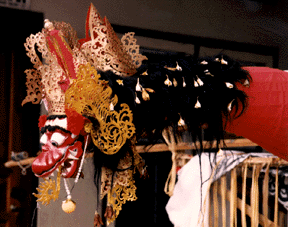
We studied it carefully but still did not appreciate it fully as we would learn later at the festival. The next day we breakfasted with the other foreign guests from Australia, New Zealand, France, Italy, England, US, Singapore, etc., grabbed our kites and drove off to the rice field where the festival was held. On the way we caught our first glimpse of the tradition surrounding the Balinese kite festival. Teams of kite flyers were carrying their kites on top of large bamboo platforms.
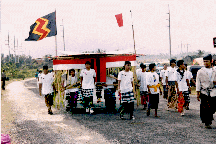
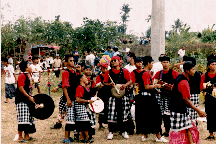
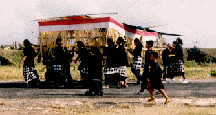
The teams were about 70-80 people. Each team had its own Gamelon band, flag bearers, team outfit, and flyers.
There was a procession of the 200 teams that had assembled as they brought the kite and the kite dock down to the field where they stored the kites.
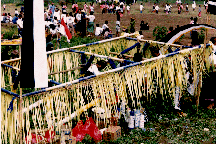 During the heat of the day the kites served as umbrellas as the team sat and ate food under the kites.
During the heat of the day the kites served as umbrellas as the team sat and ate food under the kites.
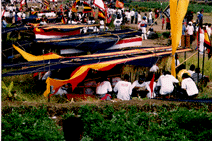
When the team was called to fly, they would carry the kite up the rice terraces about a 1/4 mile away and launch them by running down the terraces to pull the kite up into the trade winds. The first kite that flew were the traditional Balinese fish kite called a Bebean. Made of bamboo and cotton, these 45-50 foot kites had two 18 foot hummers on them, one facing up and one facing down. The Balinese say these are male and female hummers and when flown above the rice fields, the humming kites make harmony in the rice field and in the bedroom. (![]()
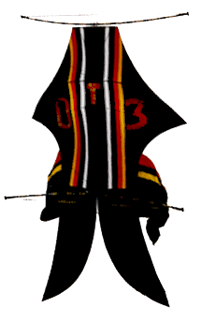 The colors of the kites are all black, red, white, and gold/yellow which represent the incarnations of the Hindu deities. Each kite is made by a local temple and usually two months in the making and testing before the festival. The kites are blessed before the event by a temple priest. Sounds these giant hummers make remind you of a digeree do or a temple drone chant. As they are launched the band revs up to a frenzy. If a kite comes down unexpectedly, everyone cheers. While these kites have no apparent dihedral, they do have the twin tails which cause the kite to correct any motion back to center, so the kite seems to swim under certain conditions.
The colors of the kites are all black, red, white, and gold/yellow which represent the incarnations of the Hindu deities. Each kite is made by a local temple and usually two months in the making and testing before the festival. The kites are blessed before the event by a temple priest. Sounds these giant hummers make remind you of a digeree do or a temple drone chant. As they are launched the band revs up to a frenzy. If a kite comes down unexpectedly, everyone cheers. While these kites have no apparent dihedral, they do have the twin tails which cause the kite to correct any motion back to center, so the kite seems to swim under certain conditions.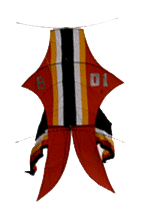
It is obvious the Balinese are into sound in their culture, for not only do the kites have hummers, and the kites have bands with them, but there are these wind machines which are placed along the flying fields behind the kite teams. These large propeller devices are placed on top of long bamboo poles and make a very loud whooping sound as the wind increases. The kite flyers can see the direction of the wind and hear the intensity of it from the sounds these windmills make. These windmills are a part of the festival and there is a contest for them based on the quality of the sound they make.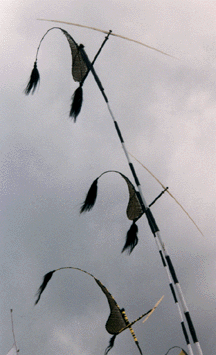
The Bebean is the most widely known kite in Bali and is flown all over the island. On the following two days, the other traditional Balinese kites were flown. One is a leaf kite, Petucan, which is very hard to fly. It is perfectly symmetrical top and bottom and bowed out to the sides. It looks like a giant eye. It too has double hummers and flown off a two point bridle. It is about 25 feet wide and about 13 feet high. The tuning of the hummers in this kite is important for the flying ability. They too are in the traditional 4 colors.
The most impressive of the traditional kites is the dragon or Janggan kite. It is about 45-50 of kite, with a fan shaped tail section and a sculpted dragon head. The requisite double hummers, one up and one down, are affixed to the body of the kite. What is impressive, however is the 300 feet of cotton tail attached to this beast. As the kite is launched, it is unfurled by the launch team, a most beautiful sight.

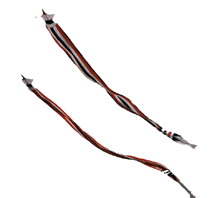
After seeing these incredible large flying machines that were so well engineered, and so conformist in design, we were totally unprepared for what happened on the final day. The kites that flew on this day are dubbed "Creation kites". These kites are perhaps best called "Creative" kites. More accurately they are three dimensional sculpture kites made from bamboo and cotton fabric. At first the kites were in the form of large birds, and one was a giant bat with fake fur on the body.

Several very tall and narrow kites were next flown which seemed to have women in various occupations (teacher, motorcycle policewoman, old witch, etc.). Then the kites came out that were even more extreme:
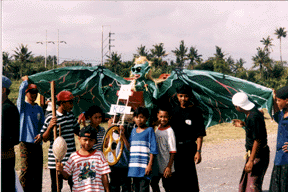
a green goblin on a tricycle
a half woman half horse goddess a large helicopter
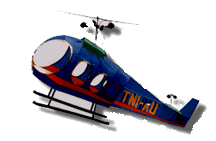
a giant crab with a frog in the claws and rotating eyes then a scale model of Mercedes truckwith turning front axles,
and a large Saturn booster rocket with counter rotating motors on them.
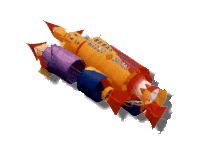
These were some of the most incredible kites I had ever seen. What was clear to me after seeing all these giant flying sculptures and the team work, was the intensity and degree to which the Balinese people have incorporated ritual, community, teamwork, and art into they kite craft. In fact on my return to the hotel on the last day, I remember hearing that some of the international guests had contacted one of the Balinese teams and were going to visit them and fly a Bebean with them. I felt pangs of jealousy. As luck would have it, our dear friend Terry Shields had apparently contracted for each of the three traditional Balinese kites to be made (in collapsible form) for shipment back to the kite museum in Long Beach Washington. The next day Terry was to go and meet the maker of his Bebean who was a master kite maker. Terry invited us to come along with Neoman Adnyana, the head of the Balinese kite society. The master kite maker, Wayan Laja, was to show Terry how to assemble the kite for flying. We set out with Terry and Neoman to Wayan's home where Terry videotaped the assembly process. For additional reference we took still photos of the process. At the end of the day we asked Wayan if it would be possible to have a smaller version of the Bebean made for us. We had in mind something reasonable like 6-10 feet. We contracted Wayan to make us the scale model kite in two weeks, which would be plenty of time before we were to return to the US. When we returned to pick it up, imagine our surprise when we realized that Wayan had built a half scale model, one that was about 18 feet long and had 10 foot hummers on it!! So now we have this giant kite which we flew at Long Beach in August 1996. It is a wonderful kite design.
We have a deep respect for the Balinese people and their love of kites. On the day before we left Bali we got to fly a large Bebean with one of Neoman's relatives and several young boys on a dry rice field. The boys loved showing us their skill at launching and flying kites. Neoman explained the ritual of the rice harvest and ritual preparation of the fields for replanting, and how flying kites over the fields was part of that ritual. Our kite even carries a blessing of coins and palm leaves to show this respect the Balinese have for the harmony of the universe.
